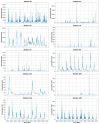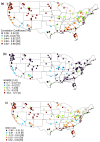Streamflow Prediction Using Complex Networks
- PMID: 39056971
- PMCID: PMC11276579
- DOI: 10.3390/e26070609
Streamflow Prediction Using Complex Networks
Abstract
The reliable prediction of streamflow is crucial for various water resources, environmental, and ecosystem applications. The current study employs a complex networks-based approach for the prediction of streamflow. The approach consists of three major steps: (1) the formation of a network using streamflow time series; (2) the calculation of the clustering coefficient (CC) as a network measure; and (3) the use of a clustering coefficient-based nearest neighbor search procedure for streamflow prediction. For network construction, each timestep is considered as a node and the existence of link between any node pair is identified based on the difference (distance) between the streamflow values of the nodes. Different distance threshold values are used to identify the critical distance threshold to form the network. The complex networks-based approach is implemented for the prediction of daily streamflow at 142 stations in the contiguous United States. The prediction accuracy is quantified using three statistical measures: correlation coefficient (R), normalized root mean square error (NRMSE), and Nash-Sutcliffe efficiency (NSE). The influence of the number of neighbors on the prediction accuracy is also investigated. The results, obtained with the critical distance threshold, reveal that the clustering coefficients for the 142 stations range from 0.799 to 0.999. Overall, the prediction approach yields reasonably good results for all 142 stations, with R values ranging from 0.05 to 0.99, NRMSE values ranging from 0.1 to 12.3, and the NSE values ranging from -0.89 to 0.99. An attempt is also made to examine the relationship between prediction accuracy and the catchment characteristics/streamflow statistical properties (drainage area, mean flow, coefficient of variation of flow). The results suggest that the prediction accuracy does not have much of a relationship with the drainage area and the mean streamflow values, but with the coefficient of variation of flow. The outcomes from this study are certainly promising regarding the application of complex networks-based concepts for the prediction of streamflow (and other hydrologic) time series.
Keywords: clustering coefficient; coefficient of variation; contiguous United States; distance threshold; nearest neighbor approach; network theory.
Conflict of interest statement
The authors declare no conflicts of interest.
Figures










References
-
- Thomas J.A., Fiering M.B. Design of Water-Resource Systems: New Techniques for Relating Economic Objectives, Engineering Analysis, and Governmental Planning. Harvard University Press; Cambridge, MA, USA: 1962. Mathematical synthesis of streamflow sequences for the analysis of river basins by simulation; pp. 459–493.
-
- Yevjevich V.M. Ph.D. Thesis. Colorado State University; Fort Collins, CO, USA: 1963. Patterns in Sequence of Annual River Flow and Annual Precipitation.
-
- Matalas N.C. Mathematical assessment of synthetic hydrology. Water Resour. Res. 1967;3:937–947. doi: 10.1029/WR003i004p00937. - DOI
-
- Carlson R.F., MacCormick AJ A., Watts D.G. Application of linear random models to four annual streamflow series. Water Resour. Res. 1970;6:1070–1078. doi: 10.1029/WR006i004p01070. - DOI
-
- Delleur J.W., Tao P.C., Kavvas M.L. An evaluation of the practicality and complexity of some rainfall and runoff time series models. Water Resour. Res. 1976;12:953–970. doi: 10.1029/WR012i005p00953. - DOI
Grants and funding
LinkOut - more resources
Full Text Sources

